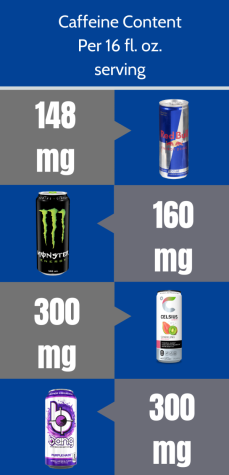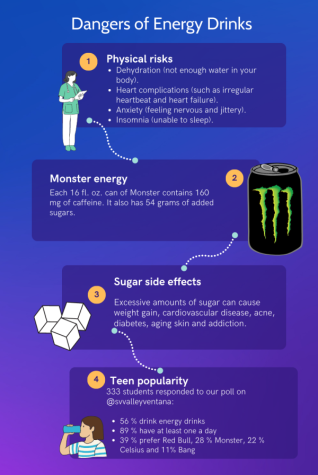Energy drink surge affects teen mental, physical health
Health organizations warn against popularity of caffeine stimulant
Senior Avery Eckert sits with a Red Bull energy drink. Red Bulls contain 148 mg of caffeine per 16 fl. oz. serving.
February 10, 2023
Tatum Tomallo drinks three Monster energy drinks–nearly 500 mg of caffeine–before the end of the school day.
But she’s still tired.
The senior is an avid consumer of the world’s most popular stimulant – caffeine. A 16-ounce can of Monster contains about 160 mg of caffeine, but many drinks have added sugars and artificial sweeteners. According to Mayo Clinic, heavy caffeine intake can cause “nervousness, insomnia, irritability and panic attacks.”

“Whenever you start taking advanced classes, you gradually lose more and more sleep,” Tomallo said.
A busy weekday for Tomallo starts about 4 a.m., when she immediately starts studying and then gets ready for school. For her first two periods, she goes to a nursing home as part of clinical rotation for her health science class.
After a day of AP English IV, AP Macroeconomics and Student Council, she heads to theater rehearsal and heads home about 5:30 p.m. Throughout her busy schedule, Tomallo has downed about three energy drinks.
On top of her current advanced courses and extracurricular’s, she is taking multiple AP tests independently at the end of the year – World History, European History, Psychology, Environmental Science and Statistics.
“I don’t usually go to bed until about 10-ish,” Tomallo said, “so, not a lot of sleep.”
Teens are the fastest growing consumers of energy drinks, despite the American Association of Pediatrics stating that children 12 and older should limit their intake to 100 mg a day.

Health organizations such as Mayo Clinic and the CDC warn against the dangers of excessive caffeine consumption.
“Over the years there has been a huge surge in the beverage industry with many new products on the market,” said Dr. Liset Leal Vasquez, Nutrition and Dietetic Director at The University of Texas at San Antonio. “Savvy social media and catchy advertisements target the teen consumer by promoting a sport or celebrity figure or another false sense of health.”
According to the Center for Disease Control and Prevention, “teachers and other school staff can educate students about the danger of consuming too much caffeine, including energy drinks.”
Pre-workout is another supplement used by weightlifters and bodybuilders to increase energy and enhance performance. School nurses have seen the result of overconsumption among teens.
“At another school, about a week before the ice storm, a student had consumed about four or five times the amount of pre-workout that she should have,” school nurse Natalie Kuhn said. “Their pulse was very high, blood pressure was high and the student was having physiological symptoms. They had to call Poison Control twice.”
Red Bull is the most popular energy drink by far, followed by Monster and Bang. Other teens consume caffeine to stay awake in class after late nights.
“I go to bed really late,” junior Gabby McClain said. “I started drinking (energy drinks) in the middle of last year, and it’s evolved into two a day. I stopped, but started falling asleep during the day again, so I had to start again.”
For Tomallo, getting off energy drinks is equally difficult. Her mental health declines as she loses more sleep but feels equally as bad as she stays up because of hundreds of milligrams of caffeine.
“It’s a really awful cycle,” Tomallo said.


